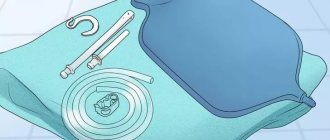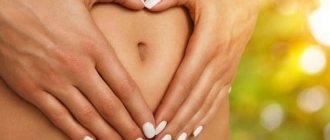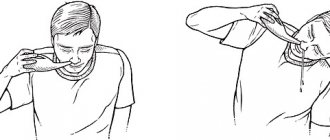Indications for use
An Esmarch mug (or simply an enema) is a reservoir with a long flexible hose (up to 2 m) that allows you to hang the vessel on a tripod. The enema works based on the laws of gravity, so it should be located above the patient, who is in a horizontal position at the time of the procedure.
In addition to the container for the solution and the hose, the enema has 2 different nozzles - soft for vaginal administration and hard for rectal use. There are also elongated versions of nozzles for deep introduction of the solution into the colon.
To control the amount of solution poured in and the speed at which it is supplied, the Esmarch mug has a special shut-off valve, making it easier to use the device at home. An enema is an effective means of cleansing the intestines, known since the times of Ancient Egypt.
It is used in the following cases:
- to soften stool when stool becomes hard;
- for administering solutions and decoctions of medicinal herbs in the treatment of inflammation;
- in the treatment of diseases associated with defecation disorders (organ prolapse, developmental abnormalities, tumor processes, dysbacteriosis, intoxication, stress);
- in case of ineffectiveness of the use of laxatives;
- in the treatment of infectious and inflammatory diseases of the urinary system;
- cleansing the body of harmful substances for the purpose of losing weight;
- in case of disturbances in the functioning of the gastrointestinal tract;
- for nutrition in severe cases of poisoning or exhaustion;
- in gynecology for various inflammations (endometritis, inflammation of the appendages), including the presence of purulent discharge;
- before surgery, childbirth and some other medical procedures.
The history of the Esmarch mug
A medical procedure such as an enema was invented by the ancient Egyptians and was actively practiced by other peoples. Initially, its purpose was to combat constipation and cleanse the intestines. However, it was soon discovered that its walls are capable of quite well absorbing various substances administered rectally.
But while some experimented in search of new pleasures and rejuvenation, others continued to work for the benefit of humanity. Among these scientists was the German surgeon F.A. Esmarch. During his long life, he participated as a medic in many wars. He made many important discoveries, without which modern medicine would not have appeared.
It was this outstanding person who came up with the idea of using a suspended vessel for washing the intestines. His innovation was a real breakthrough. The fact is that before Esmarch, an enema was done using a piston mechanism, reminiscent of a large metal syringe. It was not only extremely inconvenient, but also small in capacity. So the procedure had to be done several times.
The innovation quickly migrated from military field medicine to conventional medicine. Doctors highly appreciated the convenience of the new device, and it soon replaced its piston predecessor and has not lost its position to this day.
In what form is it produced?
An Esmarch mug, which is quite convenient to use at home, can be made of a variety of plastic materials that are resistant to treatment with sterile solutions, and differ in some characteristics.
Esmarch's irrigator
| Distinctive feature | Classification | Explanations |
| According to tank material | Silicone | The most common materials for making the device. |
| Rubber | ||
| Plastic | ||
| Metal | They are rare, mainly in medical institutions. | |
| Glass | ||
| Soft PVC | Used in disposable enemas. | |
| By method of application | Regular | Used only as an enema. |
| Combined | The enema is combined with a heating pad - the reservoir is more durable and has several lids for different uses. | |
| By service life | Disposable | Devices made of soft PVC of a transparent color (or with a tint), reminiscent of IV bags. There are sterile and non-sterile. |
| Reusable | Made from more durable materials. | |
| By tank cap type | With regular lid | Has a removable or hinged plastic cover with a lock. |
| With anti-reflux valve | The mug is equipped with a funnel-like non-spill valve that prevents liquid from flowing back out of the container. | |
| By tip type | Atraumatic | Soft rubber tip, suitable for vaginal douching. |
| Solid | Removable plastic tip, convenient as a disposable option, easy to sterilize. | |
| For deep insertion | To introduce the solution into the colon, it helps to avoid repeated cramps and urges. | |
| By type of locking device | With faucet | The most convenient and common option. |
| With clamp | In the form of a clothespin or drip clamp. | |
| With loop | Most often used in disposable devices. | |
| By mug volume | № 1 | For 1 l |
| № 2 | For 1.5 l | |
| № 3 | For 2 l | |
| 1000 | Such designations are used in disposable Esmarch mugs; the volume is measured in milliliters and corresponds to digital values. | |
| 1500 | ||
| 1750 | ||
| 2000 |
In pharmacies you can find Esmarch mugs of various manufacturers and price categories.
Some of the most common options:
- Esmarch Alpina Plast mug 1.5 l – 412.90 rub.
- Esmarch Alpina Plast mug 2 l – 436.50 rub.
- Esmarch mug (rubber) Alpha No. 1 – RUB 154.80.
- Esmarch mug (rubber) Alpha No. 2 – 161.70 rub.
- Esmarch mug (rubber) Alpha No. 3 – 170.30 rub.
- Esmarch mug (rubber) Kievguma No. 2 – 155.80 rub.
- Esmarch mug (rubber) Kievguma No. 3 – 168.00 rub.
- Esmarch sterile disposable mug Apex Honey 1500 ml – 145.00 rub.
- Esmarch sterile disposable mug Apex Honey 1750 ml – 150.00 rub.
- Esmarch sterile disposable mug Alife 2000 ml – 184.00 rub.
- Esmarch's non-sterile disposable mug Alife 2000 ml – 120.00 rub.
- Combination heating pad (Esmarch mug) Meridian 1 l – 178.00 rub.
- Combination heating pad (Esmarch mug) Meridian 1.5 l – 198.00 rub.
- Combination heating pad (Esmarch mug) Meridian 2 l – 270.40 rub.
Separately in pharmacies you can purchase any tips for the mug, the cost of which starts from 8 rubles.
Preparation of the solution
Compound
Depending on the purpose, various medications can be injected into the rectum. This leads to different methods for preparing enema solutions.
Saline solution
The advantage of saline solution is an increase in osmotic pressure in the intestinal lumen, which leads to increased peristalsis and softening of feces due to the release of interstitial fluid into the intestinal lumen.
It is prepared using regular table salt or Epsom salt, which is dry magnesia powder. In proportions: 20 g (2 tablespoons) per 100 ml of water (1/2 cup). It is administered using a rubber bulb, no more than 50 ml.
Soda solution
Soda solution is used when it is necessary to reduce painful spasms and intestinal colic. Baking soda helps reduce the acidity of stool because it is alkaline.
The solution is prepared using regular baking soda at the rate of 30 g per liter of water at the required temperature. To increase the effect, it is advisable to add a little salt, no more than two tablespoons (20 g) per liter of water.
Lemon solution
This procedure is effective for the prevention of bacteriosis, mold damage to the intestines, as well as for the treatment of helminthic infestation. Vitamin C, which is contained in large quantities in lemon juice, helps strengthen the mucous membrane, increase the tone of the vascular wall, and is used to prevent the proliferation of hemorrhoids.
It is prepared by squeezing the juice of two fresh lemons, which is diluted in a liter of water. The optimal injection temperature is 30˚C. Caution when using this procedure is only as directed by a doctor and performed only by medical personnel.
Herbal solution
This category of enema solution is necessary for cleansing the intestines during flatulence and active fermentation processes. This enema has antiseptic properties, helps prevent the growth of pathological flora in the lumen of the large intestine, has wound healing functions, and an astringent component.
It is prepared as a decoction of herbs: chamomile, yarrow, sage in equal proportions with the addition of small amounts of mint and eucalyptus. For one liter, add 2 tablespoons of dried herbs and boil for about five minutes over low heat.
Oil solution
This type of cleansing is used for severe constipation and fecal blockages to soften and smooth passage of feces. To prepare it, various vegetable oils are used: olive, sunflower, flaxseed, hemp, vaseline, and so on. 100 ml of oil is heated over low heat to 30˚C.
Then the prepared mass is injected into the rectum. After which the patient must wait 15-20 minutes, then a herbal enema is recommended before bowel movement.
Advantages and disadvantages
Esmarch's mug, which can be used independently at home is its main advantage, has firmly entered into everyday life and has become an integral part of the first aid kit in many homes.
This invention, invented back in the 19th century, owes such wide distribution to its main properties:
- does not require special medical skills - you can use it without resorting to outside help, avoiding unnecessary witnesses in such a delicate issue;
- universal – has several tips for different uses, can be used as a heating pad;
- capacious - suitable for large volumes of solutions that cannot be administered with a regular enema;
- available - sold in pharmacies everywhere, sold without a prescription;
- budget price - depending on the manufacturer, volume and type, it can vary from 80 to 800 rubles;
- easy to care for - easy to disinfect, can be used repeatedly (for reusable models).
However, the device has a number of disadvantages:
- the procedure requires certain conditions - being in a horizontal plane, having bolsters under the back, correct positioning of the patient and an enema;
- the procedure itself causes discomfort and sometimes pain;
- to hang a mug, you need a tripod or other available device (for example, a hook in the wall);
- administering an enema requires care so that at the end of the procedure no air gets into the intestines through the tube;
- The process of sterilizing the device before and after the procedure is quite labor-intensive.
What does it consist of?
Over more than a century of its existence, this instrument has not changed much. Except for the materials from which it is made. Today it is rubber, plastic and silicone.
A traditional Esmarch mug consists of the following components.
- Liquid reservoir. In terms of capacity, it can be one-, two- or three-liter. In fact, he is this very “mug”. Initially it was made of metal and ceramics and resembled a bowl. With the development of the chemical industry, it began to be made from rubber. This helped change the design of this part. Now the mug takes up less space and resembles a deflated oval rubber ball. On top there is a hole for filling liquid and a device that allows you to hang the tool.
- At the bottom, the reservoir narrows and turns into a narrow hose about 1.5 m long. It is through this that the liquid is supplied.
- A tip with a limiter is attached to the end of the hose. This removable part of the Esmarch mug can be of different lengths and thicknesses, as well as shapes. There are child and adult attachments. Most often they are plastic. However, there are those made of rubber or silicone. Ideally, each family member using such an instrument should have their own tip or it should be sterilized.
- Depending on the model, there is a clamp or tap at the end of the hose in front of the tip. It allows you to pause the procedure if necessary.
Application
Esmarch's mug, which is easy to use at home, is sold unassembled and consists of individual elements that require preliminary assembly.
The entire process of the procedure consists of 3 main stages:
- assembly and preparation of the device;
- administering an enema;
- sterilization of the device.
Assembly and preparation
The preparatory stage will depend on the type of device used - disposable or reusable:
- When using a disposable sterile mug, you need to make sure that its packaging is intact, remove the contents and begin assembly (if required), and check the reliability of the connected elements.
- The use of a reusable Esmarch mug or a non-sterile disposable version requires pre-treatment of the device.
Preparation stages:
- Wash and sterilize all parts of the mug if necessary: the reservoir with peroxide, and the tip and tube rinse under high pressure water and wipe with alcohol.
- Connect the reservoir to the tube using an adapter, and on the other side, put on the required tip.
- After sterilizing the mug, you should prepare an enema solution at the desired temperature. Typically, cleansing is carried out with a cool enema with a solution temperature of about 20 C, or a warm enema according to indications (to eliminate pain and spasms), with a maximum permissible value of 35 - 38 C. Regardless of the material used, the following solutions can be used for enema:
- herbal decoctions;
- solutions with soda;
- with potassium permanganate;
- with table salt;
- with lemon;
- with vegetable oils;
- with medications;
- with nutrients as artificial complementary foods (glucose, aminopeptin).
- Pour the pre-prepared solution into a container and secure it to a tripod so that the hose reaches the patient without tension, but does not sag below the level of the couch. Usually the mug is hung at least 1 - 1.5 m above the couch (depending on the length of the hose).
- Release the air from the hose, draining a small amount of liquid, and check the shut-off valve for serviceability.
- Lubricate the tip with Vaseline, baby oil or cream. If these are not available, sunflower oil will also work.
Administration of an enema
To carry out the cleaning procedure, several conditions must be met:
- to avoid injury, the patient should be in a relaxed state and breathe deeply;
- the mug should be vertical, above the patient;
- At the end of the procedure, there should be some liquid left at the bottom of the reservoir so that air does not accidentally enter the rectum through the tube.
The procedure for carrying out the cleaning procedure:
- Cover the couch or floor (preferably located near the toilet) where the patient will lie with oilcloth. Prepare a cushion from available materials - towels or sheets.
- If you use an Esmarch mug for vaginal douching, you must additionally have a large basin on hand into which the solution will be poured.
- The Esmarch mug, which can be used at home either independently or with the help of another person, requires the patient to take a certain pose:
- when carrying out cleansing without outside help, you should take a knee-elbow position (get on all fours) so that the level of the shoulders is lower than the level of the pelvis;
- when doing vaginal douching, lie on your back, bend your knees and tuck your legs towards your stomach;
- If you have an assistant, you should take a horizontal position on your left side (since most of the rectum is on the left) and tuck your legs.
- Carefully insert the lubricated tip with rotational movements 3 - 4 cm into the anus (it is advisable to also lubricate it with Vaseline), pointing the tip towards the navel, then change the trajectory of movement - towards the sacrum, and also slowly insert it to the remaining depth of 7 - 10 cm.
- Open the stopcock and slowly introduce the solution. If there is a strong feeling of discomfort or bloating, you should stop administering the fluid and take a short break, remaining in the same position. Continue administration by adjusting the pressure.
- Carefully monitor the amount of incoming liquid and turn off the tap without waiting until the end of the solution in the tank.
- Using the same slow rotational movements, remove the tip, squeezing the buttocks.
- Roll over onto your back and place a cushion under your buttocks to better distribute the fluid into the deep parts. Lie like this for 3 – 5 minutes.
- Then remove the roller and turn over on your right side (for the same purpose), remaining in this position for another 5 minutes.
- Get up and walk around a bit before using the toilet. The best effect will be achieved if 15-20 minutes pass between administering the enema and bowel movement. However, if you have a strong urge to defecate, you still shouldn’t endure it.
Sterilization
After using the device for its intended purpose, you need to disassemble it, rinse it with water and thoroughly sterilize all parts separately.
- Pour hydrogen peroxide into the container and shake thoroughly so that all the walls are washed with the solution.
- Rinse the tip and tube under high pressure water, boil for 3 – 5 minutes, and can be additionally treated with alcohol. It is allowed to store these elements of the device in Furacilin solution.
- Additionally, you can wipe all elements with alcohol and repeat the procedure before further use.
What is she?
Many people do not know about this cup and what its use is and even what it is called. Esmarch's cup consists of several parts:
- containers for solution;
- outlet tube;
- nozzles;
- faucet or clamp.
If you need an Esmarch mug for procedures, your doctor will tell you how to use it. In addition, instructions are included with each such product. But in any case, the procedure will be as follows:
- The solution is poured into the container.
- Liquid flows into the outlet tube.
- The solution flows through the outlet tube to the tip.
- The tip is inserted into the rectum or vagina - the liquid enters there and rinsing occurs.
Contraindications
Esmarch's mug, despite its effectiveness, can bring not only benefits to health, but also harm.
Thus, in history there are cases of death of some celebrities: according to one version, Marilyn Monroe died from a barbiturate administered through an enema, and the Marquise de Pompadour (a favorite of the French monarch Louis XV) depleted her body with regular enemas, destroying the intestinal microflora.
Harm of procedures with Esmarch's mug for the body:
- loss of the ability to empty independently – occurs during regular cleansing procedures, and therefore, the maximum allowable course of daily cleansing should not exceed 10 days;
- reverse effect of intoxication - administered solutions can break down toxins in the intestines and promote their better absorption through the intestinal walls;
- impaired intestinal sensitivity and leaching of beneficial microflora with repeated use;
- injury to the rectum by the tip (especially in the presence of hemorrhoids);
- the occurrence of nausea and vomiting, diarrhea.
Absolute contraindications to performing an enema are:
- the presence of malignant intestinal tumors;
- acute heart failure;
- bleeding hemorrhoids;
- rectal prolapse;
- inflammation of the anus;
- Crohn's disease and other diseases with ulcerative or erosive manifestations;
- diseases of the abdominal organs in acute form (peritonitis, exacerbation of ulcers, appendix);
- bleeding of the reproductive system and gastrointestinal tract;
- colitis.
Vaginal douching with an Esmarch mug is possible no earlier than:
- 2 – 3 days after the end of menstruation;
- one month after birth;
- a week after an abortion or other surgical procedures.
Carrying out gynecological manipulations using the Esmarch mug is unacceptable during pregnancy, menstruation and in the presence of acute inflammatory diseases of the genital organs.
Preparing for an enema
To prepare and successfully carry out the manipulation, it is necessary to properly prepare for the enema and arrange the manipulation site in accordance with all the rules.
Necessary equipment
To carry out the procedure, you must have the following items available:
- Esmarch's irrigator.
- The tube is about 1.5 meters long.
- A tip corresponding to the diameter of the patient's anus (there are tips for children and adults).
- Clamp.
- Vaseline, for free insertion of the tip.
Assembling Esmarch's mug
To assemble Esmarch's mug, you need to connect all its parts:
- We attach a tube with a tap (clamp) to the bulb.
- The tap or clamp should clamp the tube so that when the solution is infused, it does not leak prematurely (you can first check the infusion of a little water).
- We attach the tip to the end of the tube.
Preparing your workspace
You need to put oilcloth on the couch. The Esmarch mug should be suspended at a distance of more than half a meter above the patient's level to create a pressure difference and unimpeded fluid administration. The toilet should be located near the place of manipulation.
How to choose the right one
The choice of a suitable Esmarch mug will depend on the purpose and number of procedures performed. For a one-time enema, you can purchase a disposable sterile mug, the cost of which is significantly lower than reusable options. In medical institutions you can most often find device number 2, with a volume of 1.5 liters. This option is the most popular in pharmacies.
The attending physician will help you determine the amount of solution for the procedure. But if the procedure is carried out without prior consultation, you can rely on weight indicators to select the container of the required size:
- from 47 to 70 kg, 1 - 1.2 liters of liquid is sufficient (Esmarch mug No. 1 or No. 2);
- from 70 to 80 kg – up to 1.5 liters of liquid (Esmarch mug No. 2);
- from 80 kg – Esmarch mug No. 3, volume 2 l.
To carry out vaginal douching, the required volume of solution is determined by the gynecologist and varies from 200 to 1000 ml. Accordingly, mug No. 1 will be enough.
Esmarch's mug is a convenient option for independent use at home when performing regular cleansing enemas. However, if you have health problems or to perform therapeutic enemas, you should still seek prior consultation with a specialist and not self-medicate.
Author: Anna Lalochkina
Article design: Vladimir the Great
https://youtu.be/3ouoE2OcDWY
Colon cleansing
The most popular way to use an Esmarch mug is to cleanse the intestines. It was for this purpose that the German surgeon came up with his device. For this purpose, you need a regular attachment, which absolutely all enemas have. Colon cleansing is carried out for various reasons:
- for constipation;
- for removing waste;
- to get rid of excess weight.
Constipation can occur for various reasons. If this happens once, Esmarch’s mug will certainly help out. But if you experience frequent constipation, you should consult a doctor, as it can be a symptom of serious illness.
Alternatives to the technique
There are alternative methods of colon cleansing without the use of an enema. Basically, these are medications of various pharmacological groups that allow you to cleanse the intestines, enhance peristalsis and get rid of sludge from the body.
Their main disadvantage is the duration of action. They can be used as preparation for research or planned surgery, for the treatment of chronic constipation, but not as an emergency treatment for acute obstruction or emergency preparation of a patient for surgery.
Disinfection of the device
In addition to the fact that you need to do the procedure itself correctly, you should take proper care of the cleanliness of all parts of the device. This is important because the Esmarch mug is a reusable system.
Disinfection of each component of the device:
- Hydrogen peroxide is used to disinfect the container itself. Pour the composition into a container and thoroughly treat the walls of the vessel.
- You can clean the hose as follows: rinse with running water, boil, and store in furatsilin solution.
- The tip is disinfected in the same way as the hose itself.
Sometimes alcohol is used to clean the tip and the container itself. Simply wipe the surface with a cotton swab soaked in alcohol.
It is also important to clean the device before first use. Cleanliness and proper storage of the device will help protect a person from bacteria and germs entering the body.
Interesting facts about clyster
Klystyre (the name comes from the Greek word “klyste”, which means “to wash”) was created during the life of Hippocrates. The first device was very different from those we see now. The enema was a bubble made from the intestines of a large animal. An elderberry tube was attached to the bladder, which was inserted into the anus. The doctor inserted the end of the tube into the anus, pressed on the bladder and the liquid entered the intestines.
Since then, the clyster has changed. In some areas it was even made of metal, and a piston was used to pour water into the intestine. Scientists have found evidence where the horn of cattle served as an enema: the thin end was inserted into the anus, water or herbal infusion was poured into the horn, and the doctor blew into the wide end so that all the liquid entered inside.
E. Malysheva’s recipe for constipation
My dears, it is not expensive pills that will help you normalize digestion and stool, and relieve constipation, but a simple folk, long-forgotten recipe. Write down quickly, brew 1 tbsp. spoon.











